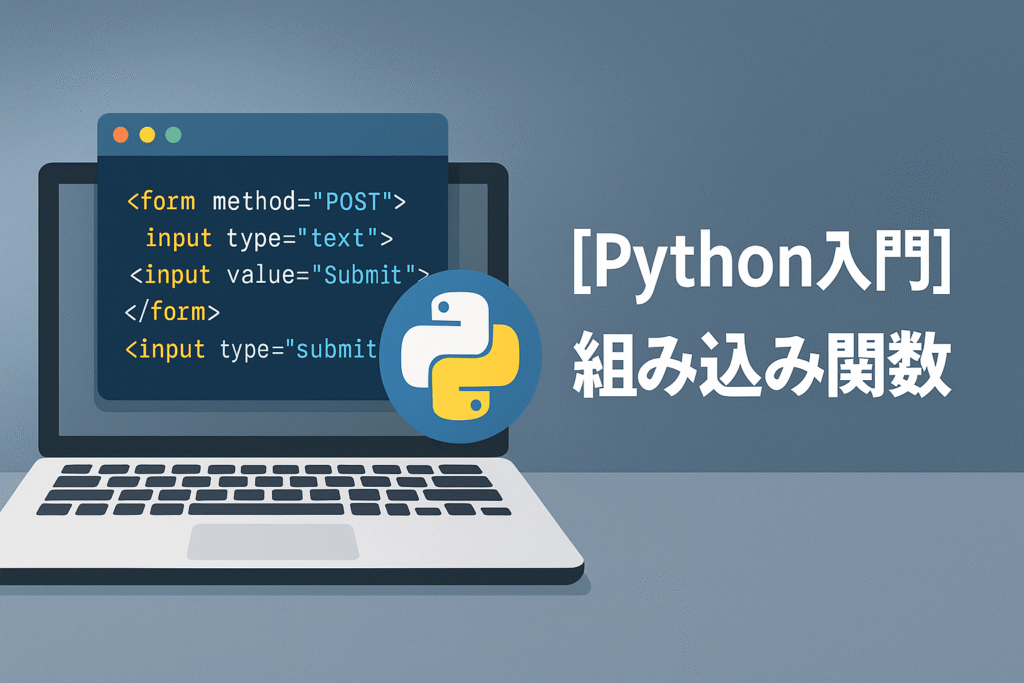ここではPythonの組み込み関数の基本から応用までを解説します。組み込み関数はPythonの核となる機能であり、プログラミングにおいて非常に重要で、便利な関数です。
以下では、組み込み関数をいくつかのカテゴリに分けて説明し、具体的なコードを用いて使用例を紹介しています。
この記事の対象

組み込み関数とは?
Pythonの組み込み関数は、Pythonインタプリタに最初から組み込まれている関数です。これらの関数は標準ライブラリをインストールせずに使用できます。Pythonの多くの基本的なタスクを簡単に実行するために使用されます。
数学関数
Pythonの数学関数は数値操作に役立つものになります。以下はいくつかの基本的な数学関数です。
abs(): 絶対値を取得する
num = -10
abs_num = abs(num)
print(abs_num) round(): 四捨五入する
num = 3.14159
rounded_num = round(num, 2) # 2桁までの四捨五入
print(rounded_num)結果
3.14max(), min(): 最大値と最小値を見つける
numbers = [4, 2, 9, 7, 1]
max_num = max(numbers)
min_num = min(numbers)
print(max_num)
print(min_num)結果
9
1文字列関数
Pythonの文字列関数は、文字列の操作とフォーマットに役立ちます。以下はいくつかの基本的な文字列関数になります。
len(): 文字列の長さを取得する
text = "Hello, World!"
length = len(text)
print(length)結果
13str(): 値を文字列に変換する
number = 42
text_number = str(number)
print(text_number)結果
42split(): 文字列を分割する
sentence = "This is a sample sentence."
words = sentence.split()
print(words)結果
['This', 'is', 'a', 'sample', 'sentence.']リスト関数
Pythonのリスト関数は、リストの操作と要素の集計に役立ちます。以下はいくつかの基本的なリスト関数です。
len(): リストの要素数を取得する
numbers = [1, 2, 3, 4, 5]
count = len(numbers)
print(count)結果
5sum(): リストの要素の合計を計算する
numbers = [1, 2, 3, 4, 5]
total = sum(numbers)
print(total)結果
15sorted(): リストをソートする
numbers = [5, 2, 8, 1, 9]
sorted_numbers = sorted(numbers)
print(sorted_numbers)結果
[1, 2, 5, 8, 9]辞書関数
Pythonの辞書関数は、辞書の操作とデータの取得に役立ちます。以下はいくつかの基本的な辞書関数です。
keys(), values(), items(): キー、値、アイテムを取得する
person = {"name": "Alice", "age": 30, "city": "New York"}
keys = person.keys()
values = person.values()
items = person.items()
print(keys)
print(values)
print(items)結果
dict_keys(['name', 'age', 'city'])
dict_values(['Alice', 30, 'New York'])
dict_items([('name', 'Alice'), ('age', 30), ('city', 'New York')])get(): キーに基づいて値を取得する
person = {"name": "Alice", "age": 30, "city": "New York"}
name = person.get("name")
occupation = person.get("occupation", "Unknown")
print(name)
print(occupation)結果
"Alice"
"Unknown" (キーが存在しない場合のデフォルト値)型変換関数
Pythonの型変換関数は、異なる型間でデータを変換するのに役立ちます。
int(), float(), str(), list(), dict(): 型を変換する
number_text = "42"
number = int(number_text)
float_number_text = "3.14"
float_number = float(float_number_text)
string_number = str(number)
list_str = "[1, 2, 3]"
my_list = list(list_str)
dict_str = '{"name": "Bob", "age": 25}'
my_dict = dict(dict_str)論理関数
Pythonの論理関数は論理値に変換したり、論理式を評価したりするのに役立ちます。
bool(): 論理値に変換する
value = 42
is_valid = bool(value) # 0以外の値はTrue、0はFalseに変換される
print(is_valid)結果
Trueany(), all(): 論理式を評価する
numbers = [1, 2, 3, 4, 5]
any_positive = any(num > 0 for num in numbers) # 1つ以上の正の数があるかどうか
all_positive = all(num > 0 for num in numbers) # すべての数が正の数かどうか
print(any_positive)
print(all_positive)結果
True
Trueファイル操作関数
Pythonのファイル操作関数は、ファイルの読み書きと操作に役立ちます。
open(): ファイルを開く
file = open("example.txt", "r") # 読み込みモードでファイルを開く
content = file.read() # ファイルの内容を読み込む
file.close() # ファイルを閉じるread(), write(): ファイルの読み書き
with open("example.txt", "w") as file: # 書き込みモードでファイルを開く
file.write("Hello, World!") # ファイルに書き込むその他の組み込み関数
Pythonにはその他多くの組み込み関数があります。以下はいくつかの例です。
range(): 範囲を生成する
numbers = list(range(1, 6)) # 1から5までの範囲をリストに変換
print(numbers)結果
[1, 2, 3, 4, 5]enumerate(): インデックスと要素を取得する
fruits = ["apple", "banana", "cherry"]
for index, fruit in enumerate(fruits):
print(index, fruit)結果
0 apple
1 banana
2 cherryzip(): 複数のイテラブルを結合する
names = ["Alice", "Bob", "Charlie"]
scores = [95, 88, 75]
zipped_data = list(zip(names, scores))
print(zipped_data)結果
[('Alice', 95), ('Bob', 88), ('Charlie', 75)]応用例: 組み込み関数の活用
組み込み関数は、データ処理、リスト内包表記、条件式の簡略化など、さまざまな場面で活用できます。以下はその一部です。
# データ処理
numbers = [1, 2, 3, 4, 5]
squared_numbers = [num ** 2 for num in numbers] # リスト内包表記を使用して各要素を二乗する
print(squared_numbers)
# 条件式の簡略化
age = 18
is_adult = age >= 18 # 年齢が18以上かどうかを判定
print(is_adult)結果
[1, 4, 9, 16, 25]
Trueまとめ
この記事では、Pythonの組み込み関数の基本的な使用方法と応用例を紹介しました。これらの関数を効果的に活用することで、Pythonプログラムの開発がスムーズに進み、コードが簡潔になります。 Pythonの公式ドキュメンテーションには、さらに多くの組み込み関数に関する情報が提供されています。是非、公式ドキュメントを参照してみて下さい。











